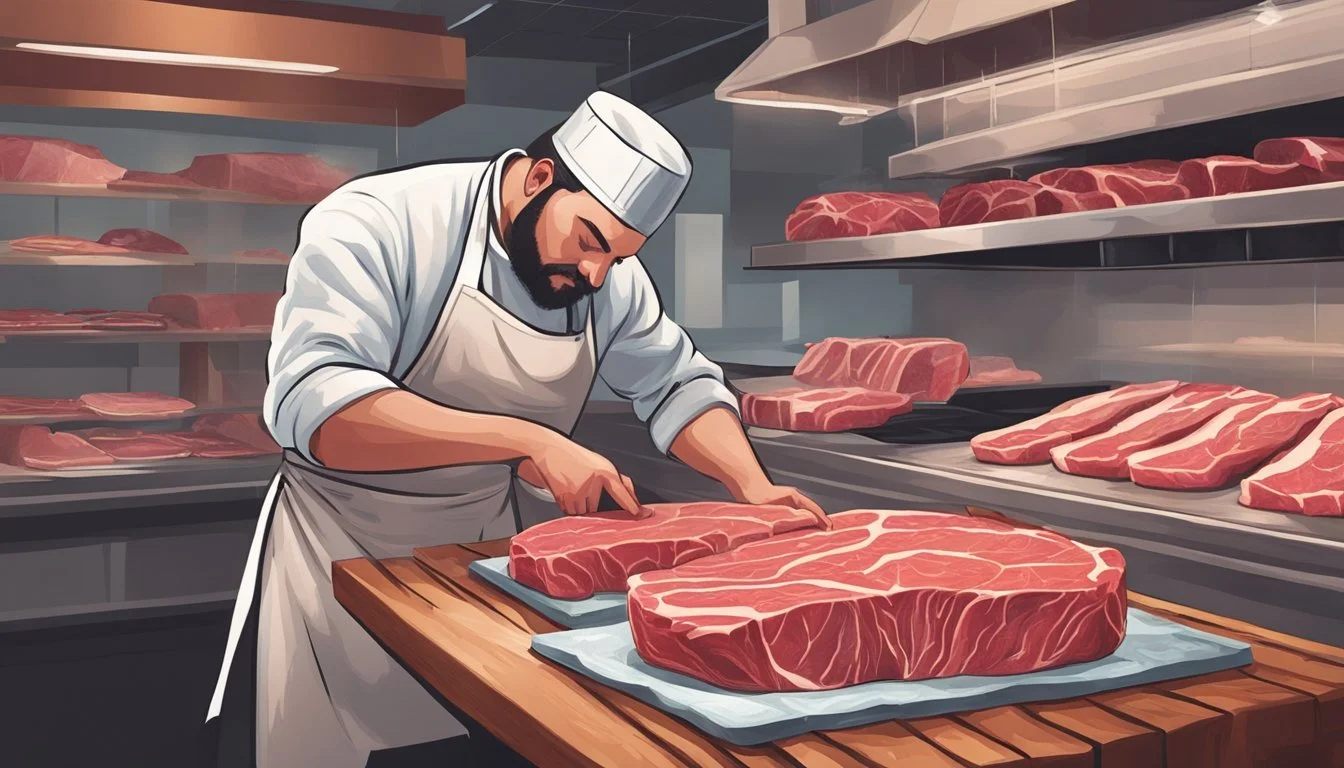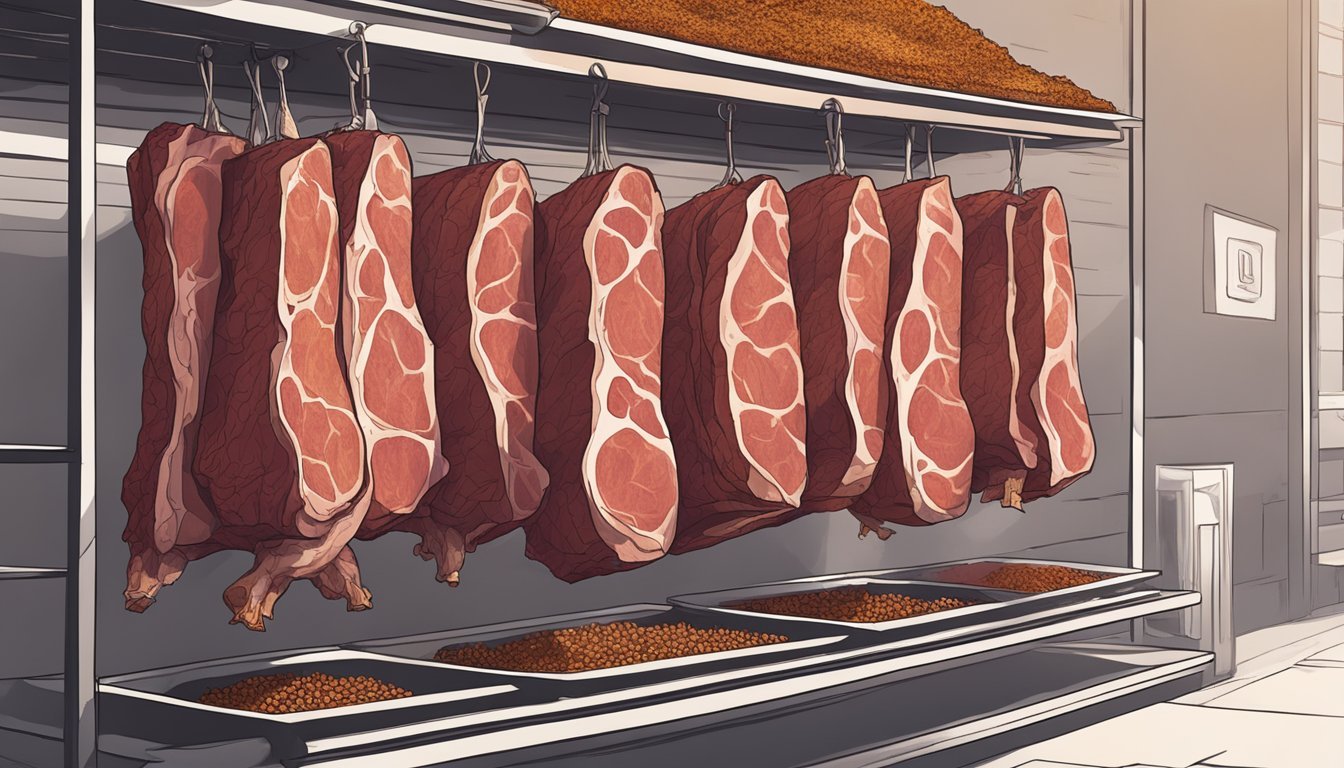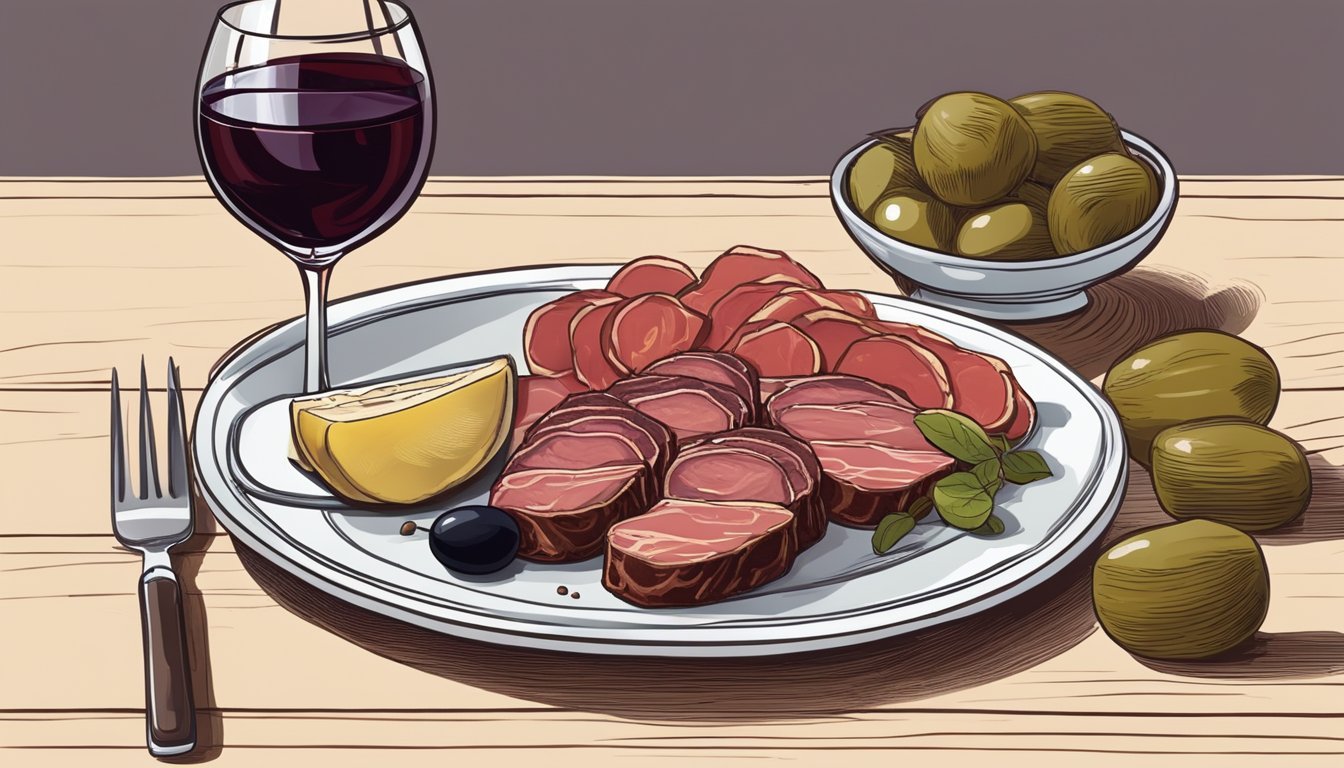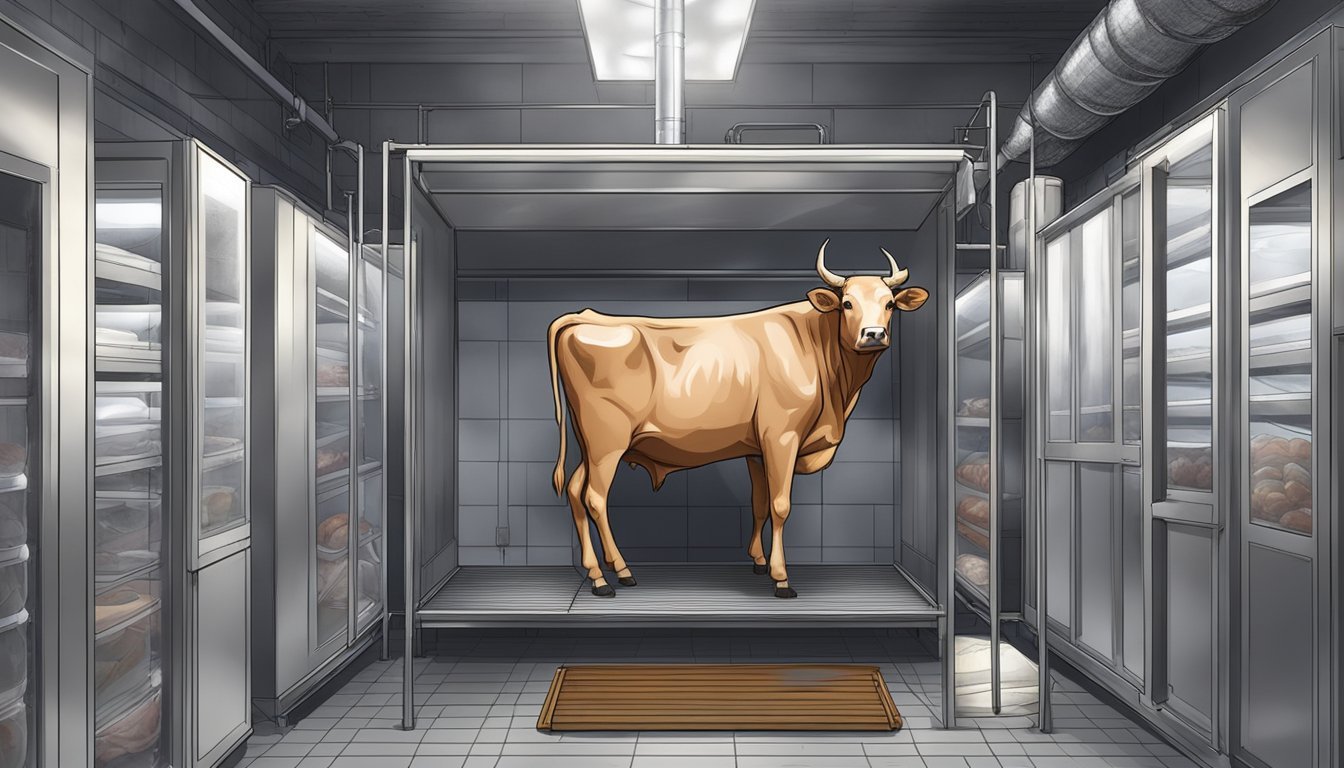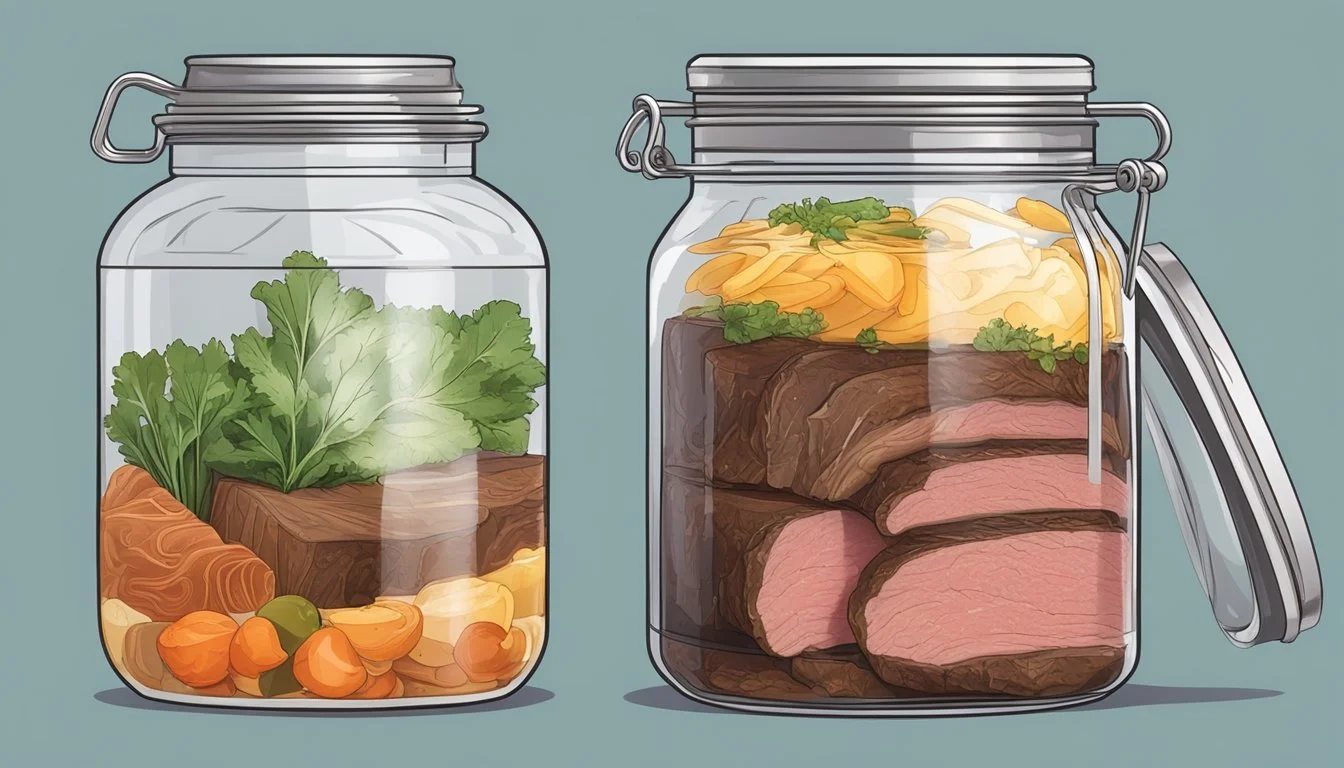How to Ferment Pastirma
Mastering the Art of Air-Dried Cured Beef
Pastirma, a highly seasoned air-dried cured beef (What wine goes well with beef?), is a cherished delicacy originating from Central Asia and popular across various Middle Eastern and Mediterranean cuisines. The art of making pastirma involves a careful process of curing and fermenting beef under specific conditions, which culminates in a product known for its robust flavor and distinctive aroma. This preservation method not only extends the shelf life of the meat but also enhances its taste, making pastirma a sought-after component in many culinary traditions.
To craft pastirma, one begins with quality beef, commonly a cut like fillet mignon, which is then trimmed of excess fat and sinew to ensure an even curing process. The meat is thoroughly rubbed with a cure mixture containing salt and other curing agents such as nitrates or nitrites, which serve to prevent spoilage and promote the development of the pastirma's characteristic deep red color. This initial stage is crucial as it sets the foundation for the meat's transformation.
After the meat has been coated with the cure, it is left to rest, allowing the blend of spices and curing agents to penetrate deeply. During this period, the moisture within the meat gradually reduces, commencing the air-drying process. This practice of dehydrating the meat in a controlled environment plays a vital role in concentrating the flavors and fostering the desired texture that pastirma is known for. Patience is key, as this phase can take several weeks, during which the meat's progress is monitored and the conditions adjusted to achieve the perfect harmony of taste and preservation.
The History of Pastirma
Pastirma, a highly seasoned air-dried cured beef, has a longstanding heritage that stretches back to Central Asian origins and spans across the Middle East and Balkans, embedding itself in various culinary traditions.
Origins in Central Asia
The roots of Pastirma can be traced to Central Asia where ancient techniques of meat preservation were essential for nomadic tribes. Pastirma is believed to have developed from these early methods as a practical solution to preserve meat for long periods. The name itself is thought to have derived from the word bastırma, which means "to press," referring to the pressing of the meat during its drying and curing process.
Adoption Across the Middle East and Balkans
As the Turks migrated westward, they brought Pastirma with them, leading to its widespread adoption throughout the Middle East and Balkans. In the Byzantine era, a similar food called apokt was made, hinting at an interchange of culinary practices. Armenia also has a notable history with Pastirma, known locally as apukht, with records mentioning it as far back as the reign of Tigranes the Great in the 1st century BC.
During the Ottoman Empire, Pastirma became a delicacy in Turkey, praised by the 17th-century Ottoman explorer Evliya Çelebi. Its popularity spread, finding a place in the cuisines of countries such as Egypt, the Levant, and within Armenian and Greek communities. Additionally, variations of Pastirma emerged in the Balkans with Albanian, Azerbaijani, Romanian, and Balkan twists on the traditional dish, showcasing its regional adaptations and the rich tapestry of its historical journey.
Selecting the Right Cut of Meat
When fermenting pastirma, the choice of meat is crucial for taste and texture. The cut of meat determines the curing process's success and the final product's quality.
Why Eye of Round is Preferred
Eye of Round is the choice cut for fermenting pastirma due to its uniform shape, which allows for even drying and curing. This cut, sourced from the rear leg of beef, is lean with minimal connective tissue, resulting in a product that is both tender and flavorful after fermentation and curing. The consistent thickness means that it can cure evenly, avoiding issues like unevenly dried or overly tough sections in the final product.
Alternatives to Eye of Round
While Eye of Round is traditionally preferred, there are several alternatives that can be used for fermenting pastirma:
Filet Mignon: A tender option, albeit more expensive, which comes from the smaller end of the tenderloin.
Leg: Specifically, the upper part of the leg of beef offers a good balance of meat and fat.
Lamb: For those who desire a different meat variety, lamb provides a rich flavor and is a suitable alternative to beef.
Water Buffalo: In some regions, water buffalo is used for a unique taste and higher fat content.
Mutton: Another beef alternative, mutton from older sheep, offers a stronger flavor profile.
It's important for the chosen cut to be lean, with a consistent thickness, to ensure proper curing and drying for quality pastirma.
Preparing the Beef for Curing
Proper preparation of beef is the cornerstone of creating quality pastirma. The process requires attention to detail, especially when trimming, salting, and using the equilibrium cure method to ensure consistent flavor and texture.
Trimming the Fat
One begins by selecting a lean cut of beef and removing excess fat. It's important to eliminate the silver skin, then trim the fat based on preference for a leaner end product. Since fat does not cure, removing it helps to avoid spoilage and ensures an even distribution of the salt and spices.
Salting the Meat
Salting is a crucial step for moisture removal and preservation of the meat. One typically uses kosher salt for its purity and texture. The meat is generously covered with salt, which assists in drawing out moisture, setting the stage for a successful dry curing process. Optionally, a small amount of sugar can be added to balance flavors.
The Equilibrium Cure Method
The equilibrium cure method leverages precise measurements to cure the beef without the risk of oversalting. The exact weight of the meat is used to calculate the amount of salt (typically 2.5-3% of the meat's weight), ensuring a consistent result. Ingredients for the cure — a blend of salt, curing salts (such as Cure #1), and various spices — are combined and rubbed thoroughly onto the beef.
Ingredients: Cure is composed of a calculated amount of salt, curing salts, and a specific spice blend.
Humidity: During the curing process, maintaining correct humidity levels is crucial to prevent overdrying or mold formation.
Curing Time: The meat should be cured under refrigeration, with time dependent on its thickness, generally following the guideline of 1.5 days per centimeter of meat thickness.
By adhering to these steps, the beef will be properly prepared for the next stages of pastirma making, ultimately leading to a well-cured and flavorful delicacy.
Creating the Spice Mixture
The creation of the spice mixture is a crucial step in preparing pastirma, as it defines the flavor profile of the finished product. Precise blending and application of the spices ensure the meat is not only preserved but also infused with the traditional aromas and tastes.
Essential Spices in Pastirma
The essential spices in the pastirma spice blend are fenugreek, paprika, garlic, cumin, and black pepper. Each spice plays a specific role:
Fenugreek (chaman) adds a bitter and aromatic taste, which is signature to pastirma.
Paprika provides a sweet pepper flavor with a vibrant red color.
Garlic, used either fresh or as granules, injects a pungent and robust taste.
Cumin infuses a warm and earthy note.
Black pepper introduces a sharp, woody flavor.
For a bit of heat, cayenne or red pepper flakes can be added according to taste.
Mixing and Applying the Cemen Paste
Cemen paste is at the heart of pastirma's unique taste. To prepare the cemen, one must finely grind the spice blend into a powder. Cumin paste, made from ground cumin seeds, acts as a binder for the spices.
The spice mixture typically includes (for every kilogram of beef):
2 tablespoons of ground fenugreek
2 tablespoons of paprika
1 tablespoon of ground cumin
2 teaspoons of ground black pepper
1 tablespoon of garlic granules or minced fresh garlic
1 teaspoon of cayenne (optional for added heat)
To combine the spices, they are mixed thoroughly to ensure uniformity. The cemen paste is formed by adding enough water to the spice blend to create a thick paste. This paste is then liberally applied to the cured meat, enveloping it in a fragrant, colorful crust that will contribute to pastirma’s distinctive taste and aroma during the drying process.
Drying and Maturing Process
The drying and maturing process of Pastirma is critical for developing its distinct texture and flavor. Proper air-drying techniques, as well as strict control of temperature and humidity, ensure the desired quality. The determination of the right drying time is essential to yield the spiced, air-dried beef with its unique, salty taste.
Air-Drying Techniques
To achieve successful air-drying, Pastirma should first be hung in a well-ventilated area. The airflow around the meat must be consistent to facilitate uniform drying. Utilizing a clean space free from contaminants also ensures the safety and quality of the resulting product.
Controlling Temperature and Humidity
Temperature and humidity are two pivotal factors in the drying process. Ideal conditions typically range between 60-70°F (15-21°C) for temperature and 60-70% for humidity. Maintaining these conditions prevents the growth of unwanted bacteria while allowing Pastirma to dry gradually and develop its flavors.
Determining the Right Drying Time
The right drying time is typically gauged by the thickness and size of the beef cuts, with most Pastirma requiring several weeks to dry completely. A balance is sought where the outer layer is sufficiently firm but not overly hard, while the inside remains moist yet fully cured. Regular checks are customary to ensure the process is proceeding as expected.
Serving and Enjoying Pastirma
Pastirma, with its intense flavor and rich history, is a versatile cured meat that has been savored in various cuisines. When serving, one should consider the balance of spices and the distinct texture of this air-dried beef to complement dishes and create a delightful culinary experience.
Traditional Pairings and Dishes
In Turkish and Middle Eastern cuisines, pastirma is often presented as an appetizer or part of a meze platter, typically accompanied by a variety of cheeses and olives. For a traditional breakfast, thin slices of pastirma may be lightly fried and served with eggs, often in an omelet, enhancing the morning meal with a rich protein boost.
Common traditional dishes include:
Pastirma-Egg Omelet: Eggs whisked and fried with slices of pastirma.
Pide with Pastirma: Turkish flatbread topped with pastirma, sometimes with cheese.
Pastirma with Melon: A classic pairing, as the sweet melon contrasts the savory pastirma.
Servings: It's important to serve pastirma in thin slices to appreciate its concentrated flavors and to ensure it complements rather than overwhelms the accompanying foods.
Alternative Uses in Modern Cuisine
Chefs in modern kitchens have begun to experiment by incorporating pastirma into innovative dishes, moving beyond traditional boundaries. Sliced pastirma can be used to add a punch of flavor to salads, pizzas, and even pasta dishes, where its spiced umami quality adds a new dimension.
Innovative ideas with pastirma:
Salad Topping: Toss thin slices into a green salad for a savory note.
Pastirma-Infused Burgers: Blend chopped pastirma into burger patties.
Gourmet Pizza: Top pizza with pastirma slices and complementary flavors like arugula and a drizzle of lemon.
When utilizing pastirma in modern cuisine, one should acknowledge its strong taste and adjust the quantity and accompanying spices accordingly to achieve a well-balanced dish.
Cultural Significance and Variations
Pastirma, known under various names, holds a crucial place in the culinary traditions of numerous cultures across Eastern Europe and the Middle East. It is not only a staple food but also a symbol of shared history and artisanal craftsmanship in meat preservation techniques.
Pastirma's Role in Different Cultures
Historically, pastirma has been linked to the region that stretches from the Levant through Armenia to the Balkans and beyond. In Armenia, it is referred to as basturma and is closely connected to ancient traditions dating back to the era of Tigranes the Great between 95 and 45 BC. Armenian dry-cured beef, known for its distinctive flavor, is an important facet of Armenian charcuterie (What wine goes well with charcuterie?).
In Turkey, where it is spelled pastırma, it is traditionally made by pressing seasoned, air-dried beef which adds to its unique texture and taste. It's a popular ingredient in many dishes and is enjoyed in slices as part of a rich charcuterie board.
Variations from Armenia to the Balkans
Different regions have developed their own versions of pastirma, each with a unique taste profile, method of curing, and preferred type of meat. For example, while beef is commonly used, meats such as camel (highly valued particularly in Middle Eastern countries), lamb, goat, and water buffalo are also seen.
Azerbaijan and the Balkans: Versions of pastirma in these regions might be called bastırma or basterma, where variations could include the addition of specific spices that cater to local tastes.
Greece (known as pastourma) and other Balkan countries such as Bulgaria, Romania, and Albania: Alternatives to this traditional cured meat are widespread and sometimes include variations similar to the Italian bresaola or the better-known pastrami.
Cured meats (What wine goes well with cured meats?) like pastirma and its regional variants are pivotal in the culinary practices of these cultures, often appearing alongside salami, prosciutto, and other cured delicacies in a diverse array of charcuterie offerings.
Storing and Preservation
To ensure Pastirma retains its flavor and texture, proper storage and preservation are crucial. Maintaining the right conditions plays a significant role in extending this cured meat's longevity.
Optimal Conditions for Longevity
The optimal storage of pastirma involves a balance of temperature and humidity to prevent spoilage and mold growth. One should aim for a cool, dry environment, resembling conditions of a typical winter, with temperature hovering around 60-65°F (~15-18°C) and relative humidity at 60-75%. These conditions can usually be replicated in a cellar or a specialized curing fridge, where controlled environment is key for the proper drying out process. Regular monitoring is recommended to ensure the parameters remain constant.
Freezing vs. Refrigeration
Pastirma can be stored either by freezing or refrigeration, and each method affects its longevity and quality differently.
Refrigeration (Fridge):
Humidity: Low
Temperature: 35-40°F (1.7-4.4°C)
Longevity: Several weeks
Texture: Maintains tenderness
Servings: Ready to consume
Refrigeration is ideal for short-term storage, keeping the pastirma tender and ready to consume.
Freezing:
Humidity: N/A
Temperature: 0°F (-18°C) or below
Longevity: Up to several months
Texture: Can become firmer
Servings: Requires thawing before consumption
Freezing is suitable for long-term storage, extending pastirma’s shelf life by several months. One must thaw the meat in the refrigerator before serving to ensure best taste and texture.
Health Considerations and Nutritional Value
In assessing the health considerations and nutritional value of Pastirma, one needs to take into account its high protein content along with its caloric, fat, and salt makeup. It's important to understand how to balance its consumption within a healthy diet.
Protein Content and Caloric Value
Pastirma is a protein-rich food. Given that it is made from beef, it typically contains a significant amount of protein, which is crucial for muscle repair and growth. On the other hand, Pastirma is also calorie-dense due to its fat content and the preserving oils added during the curing process. As it is air-dried and concentrated, the caloric value can be high. Consumers should consider this when incorporating Pastirma into their diet, especially if they are monitoring their caloric intake.
Average Protein Content: About 20-30 grams per 100 grams
Estimated Caloric Value: 250-350 calories per 100 grams
Balancing Consumption with a Healthy Diet
Incorporating Pastirma into a balanced diet requires moderation, particularly because of its high sodium levels, which result from the curing process. High sodium intake can lead to increased blood pressure and other cardiovascular issues. It also contains saturated fats, which are important to monitor for maintaining heart health.
Recommended limit of sodium intake per day: <2,300 mg
Moreover, due to the curing process, it may contain nitrates and nitrites, additives used to preserve color and prevent bacterial growth. While these additives are generally recognized as safe in regulated quantities, their presence prompts for mindful consumption.
For those monitoring their diet, it could be a good idea to consume Pastirma in smaller portions, paired with vegetables or whole grains to offset its salty nature and add balance to the nutritional profile.
Pastirma in the Modern Kitchen
Pastirma, with its rich history rooted in Turkish cuisine, has found a contemporary place in modern kitchens. Chefs and home cooks alike are discovering innovative ways to incorporate its bold flavor into a variety of dishes.
Contemporary Recipes and Innovations
Recipes for pastirma in the modern kitchen often take inspiration from its traditional roots, while incorporating new ingredients and techniques. For instance:
Breakfast: A traditional Turkish breakfast may feature slices of pastirma, but modern variations include it in omelets, providing a savory depth to the start of the day.
Appetizers: Pastirma pairs well with an array of cheeses and can be a key ingredient in appetizers, often served alongside fruits such as dates for a sweet and salty contrast.
Ingredient: Potato
Use in Pastirma Dish: Sliced thin and fried with pastirma for savory crisps
Cuisine Twist: Infused into dishes from other cuisines like pastirma-spiced pasta
Home cooks should note that the key to a successful pastirma recipe lies in balancing its intense flavor with other components of the dish.
Infusing Pastirma Flavors into New Creations
Pastirma's unique taste profile lends itself to infusing flavors into new culinary creations. Its boldness transforms the foods it's combined with, such as:
Wine Pairing: When served as part of a charcuterie board, pastirma's bold flavors are complemented by robust red wines.
Kayseri Influence: Drawing from the city of Kayseri, known for its excellent pastirma, chefs may incorporate its spice mix into various dishes to emulate its signature taste.
It is not uncommon to see pastirma making an appearance in non-traditional settings, signifying its versatility and global appeal in modern culinary practices. Recipes are adapted to merge pastirma with other culinary traditions, emphasizing its adaptability and capacity to enhance flavor profiles across diverse dishes.
Conclusion
Making pastirma requires patience and attention to detail. It begins with the preparation of the meat, ensuring all silver skin is removed and fat is trimmed to preference. The curing process is critical; it involves applying a precise mix of cure spices to the meat, which should then be left to rest. The spices typically include fenugreek, cumin, garlic, and hot paprika.
During fermentation, one should maintain a controlled environment with optimal temperature and humidity, which facilitates the growth of beneficial bacteria necessary for curing. Regular checks are important to monitor the process and identify any potential issues early on.
Pressing the meat helps to expel blood and salt, making sure the flavor is concentrated and the texture is consistent. Coating the meat with 'Cemen' paste marks the final stage, imparting the unique flavor that pastirma is known for.
Air-drying should continue until the pastirma achieves the desired level of dryness. The entire process, from preparation to completion, can span several weeks.
Storage is also an essential aspect, with pastirma needing to be kept in a cool, dry place to prolong its shelf life and maintain its quality.
For enthusiasts looking to explore the rich flavors of the Middle East and Eastern Europe, perfecting pastirma offers a deeply satisfying challenge. Properly done, pastirma is a delicacy that encapsulates a time-honored tradition of meat preservation, enjoyed across cultures for its distinctive taste and texture.



